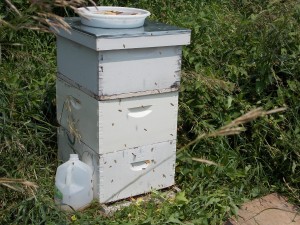Learn Beekeeping. Want to be as busy as a bee?
It’s beekeeping time. Yep, even with snow on the ground - now is the time to get started.
Winter beekeeping is relaxed, it’s about learning, dreaming and planning. It’s the time for researching and experimenting.
It's the perfect time to build hive bodies, supers, and frames. Painting them is fun too. Spring doesn't seem so far away when you're busy.
I was reading about an experiment published in the Fifth Annual Report of the State Bee Inspector for the year 1916. It was reported that hives painted darker colors
outperformed hives painted white. Our hives have always been white. Boring. Not this year, though. The new hives are bright colors. Vibrant and happy colors. It will be interesting to see if these hives are more productive than the white ones.
Another experiment this spring will be splitting hives using strong brood frames and swarm cells containing new queens.
When the hives were closed up for the winter there was plenty of honey and pollen for feed. This is a critical time of year. Bees can easily starve late in the winter or early in the spring. In the next few weeks the queen will start egg laying again, she'll build up brood.
It was warm enough to open up the hives the other day, just for a quick minute to add pollen patties. The bees were clustered, they looked healthy.
This is a great time of year to learn beekeeping.
Sign up for beekeeping classes, they’re starting soon. There’s plenty of time to learn by taking classes and reading books.
Here are a couple of good books on beekeeping:
Natural Beekeeping by Ross Conrad
The ABC and XYZ of Bee Culture Forty First Edition published by The A.I. Root Company
Bee Keeping for Dummies by Howland Blackiston and Null
Here’s a list of classes in Iowa and Illinois:
The Iowa Honey Producers Association
The Illinois State Beekeepers Association
Here's a list by state:
The American Honey Producers State Organizations






 And now, another lesson from a very
And now, another lesson from a very  Using an old window screen, placed over the hive body, I dump a pound of powdered sugar on top. It's important to have the smoker ready to force the bees away from the screen. Using a bee brush to gently spread the sugar across the screen so it falls between the frames, I continue to apply smoke. You don't want the bees clinging to the screen because the brush will damage the bee's legs, sometimes amputating them.
Using an old window screen, placed over the hive body, I dump a pound of powdered sugar on top. It's important to have the smoker ready to force the bees away from the screen. Using a bee brush to gently spread the sugar across the screen so it falls between the frames, I continue to apply smoke. You don't want the bees clinging to the screen because the brush will damage the bee's legs, sometimes amputating them.




 On Sunday night we had snow. Monday's overnight temperature was 20 degrees. It was cold this morning, but I got the call that our bees were ready to be picked up. It seems too cold for bees. I put them in the back of the truck and they were very quiet. A few stragglers were clinging to the outside screen. As the car warmed up, so did the bees. Their buzzing got louder and stronger. I turned up the radio so that I wouldn't hear them. Driving with six-thousand bees in your car
On Sunday night we had snow. Monday's overnight temperature was 20 degrees. It was cold this morning, but I got the call that our bees were ready to be picked up. It seems too cold for bees. I put them in the back of the truck and they were very quiet. A few stragglers were clinging to the outside screen. As the car warmed up, so did the bees. Their buzzing got louder and stronger. I turned up the radio so that I wouldn't hear them. Driving with six-thousand bees in your car 